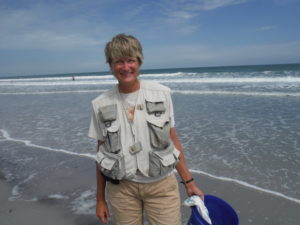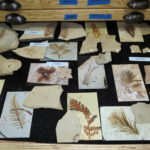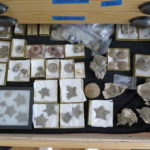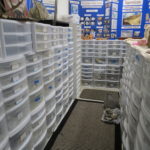This issue, Jennifer Bauer interviews Linda McCall. Linda serves on Paleontological Society’s Ad Hoc Committee on Government Affairs and the myFOSSIL Steering Committee. Linda is a member of numerous fossil organizations.
Tell us a little about yourself.

Thank you for this opportunity. I am an avocational paleontologist first and foremost but have always been a naturalist at heart – just as willing to pick up an abandoned bird or wasp nest or bird egg or bleached out modern bone or sparkly crystal as I am a fossil. (And photograph them all as well!) During my early college years I worked with the local Science Center to foster rescued injured animals – ask me about the fawn I kept in my apartment for 3 weeks… or the sparrow who didn’t leave once it recovered.
How and when did you first get interested in collecting fossils?
My mother always referred to me as an “active” child – which was a kind way of saying I sometimes drove her to distraction. We were living in Columbus, Ohio when I was about 6 (my father was a pilot in the Air Force, so we moved around a bit), and attended the local Methodist Church. I would get bored waiting for church to open and my mother would send me out into the limestone gravel parking lot to find whatever took my fancy. I would bring her back bits of sparkly crystal or broken crinoid stems and she would tell me what they were (my mother had been a chemistry major at college in the mid-to late forties, which was unusual in and of itself.) We moved to Texas when I was twelve and fossils were EVERYWHERE and I was hooked. Collecting started in earnest and I wanted to grow up to be a paleontologist!
Why didn’t you go on to be a professional paleontologist?
My career as a professional paleontologist showed initial promise. In high school I displayed my collection at the school library and gave talks to fellow students. I enrolled at the University of Texas as a Geology major and was privileged to work at the J J Pickle Research Center in the Vertebrate Paleo Lab under Dr. Wann Langston and Dr. Ernie Lundelius as a freshman – the only freshman there. I wanted to grow up to be just like them – digging in the field and making exciting discoveries and publishing them to increase our knowledge of the world. This was in 1976.
I soon learned that while some members of the paleo world were welcoming and accepting of a woman (like Wann and Ernie and the rest of the folks at the lab) others were not – mainly my school counselors. They convinced me that the only job I would have in paleontology was working in oil and gas with microfossils in an office somewhere. Bummer that! I’m out. So, I dropped out, got married went to work at an insurance stat gathering agency (I do like math), had children and joined a local fossil club – pursuing fossil collecting as a hobby.
I understand you have been the lead author in several peer reviewed published paleontological papers. How long have you been involved in paleontological research? I know you have collected early echinoderms with Dr. Jim Sprinkle! Can you tell us about your experience working with professional scientists?
In the early ‘80s, on a field trip to Oklahoma with the Austin fossil club (Dr. Sprinkle was along as science advisor for the club). I found a nearly complete specimen of a new echinoderm that Jim had been researching (he had a couple partial specimens of it already). He suggested that our fossil club take on the project of writing the new species up, so we did, and in 1985, with his guidance and mentoring, it was published. (My last name was Henry back then…. I was 28 at the time.) 1

Then there is a big gap of child-raising and just collecting on the side. I’ve always been something of a “super collector” and I never really abandoned the dream of doing something with the fossils I found to increase our knowledge of the natural world in some way. In 2006, my “super-collecting” came to good use. Interstate 35 was being widened in Georgetown, Texas (just north of Austin) and the Austin Gem and Mineral Club folks (of which I was also a member) said to go check it out because there were some awesome calcite crystals and some cool speleothems (cave formations) coming out of some of the small voids they were exposing on a 13ft high limestone wall they were cutting through. I went to look and found instead one small crystallized fossil! I kept watch on the site for a month and when they finally reached the fossil layer again, I collected it like crazy.
I wanted to do something with all that material and I wanted to figure out what it said about the site and the environment back then, but didn’t know where to start. I showed some of the material to Dr. Sprinkle and Dr. Ann Molineux (the fossil club science advisors at the time) and they said, “Why don’t we write a paper about this?” I said, “Wonderful!” They said, “Why don’t you be lead author.” I said, “Are you crazy? I don’t have any idea how to do that!” And they said, “It’s fine, we’ll help you” – so they gave me an outline and I wrote the paper in layman language and they helped me upscale it into scientific language and taught me the terminology and off we went. The paper was written, accepted and I did my first presentation at a professional conference in 2008 at age 51. The paper won the second place Grover E. Murray Best Published Paper Award at the conference (which I credit entirely to my professional co-authors), and has since been reprinted in the South Texas Geological Society Bulletin.2
We teamed up again for two more papers, adding another avocational published author Chris Garvie foron. 3,4
Working with these professionals has been wonderful. They are warm and open, helpful, and nurturing – guiding and mentoring me through the maze of abstract writing, technical writing, convention attendance and oral presentations, and introduced me to an entirely different world.
I have since gone out on my own, and though I haven’t published solo yet, I have done numerous abstracts and a like amount of oral presentations at professional conferences on topics as varied as the color on echinoderms to Paleontological Resources Preservation Act (PRPA) impacts on amateur paleontological publishing and the value of amateur/avocational paleontologists to the field of paleontology (see list under Learn More below). In April 2018 I co-chaired my first session at the Southeastern section meeting of the Geological Society of America in Knoxville, Tennessee.
I saw your talk on coloration patterns in fossil echinoids at the Geological Society of America meeting this year. What caused you to pursue that project? Are you teamed up with other local scientists?

One of our club members tipped us off that they were replenishing the sand on North Topsail Beach and that the new sand had fossils in it, so I went down to check. Indeed there were, and for a long time I was collecting them without noticing the color – after all 30 million year old fossils shouldn’t still have any color or color patterns on them so I wasn’t looking for it. But, being a super collector, when you’ve picked up a bazillion of them, you can’t help but notice when there are replicating color patterns on them, different from random mineral color staining. So then I started looking for it, and the more I looked, the more I found. There are color patterns on specimens from at least 6 different species from 3 different phyla. For the presentation you mentioned I focused on the color and color patterns on the echinoderm (irregular sea urchin) Hemipatagus carolinensis. After 5 years of trying to convince the professional community that I do indeed have original color patterns, if not color, well known echinoderm expert Lou Zachos at the University of Mississippi has agreed to work with me and get these findings published. Yay!
I notice you work on many types of echinoderms – are they your favorite group or do you have a favorite fossil?
I guess I would have to say I am a generalist and like different things on different days. I do favor invertebrates though – all invertebrates. Teeth and bones, not so much.
I understand you have a sizable personal collection. Can you tell us about it?
Just in the last year we have moved into a house that allows me to really let my collection shine. I love having the space to display and have easy access to my collection, and love to have folks over to share it with. Come visit me! I don’t live near a museum or university, so it is also handy to have my own research material close by.
I also understand you have donated many specimens over the years. What is that like?
Well, after collecting sporadically since age 12 and pretty continuously for the last 20 years, the amount of material can get a little out of hand. When my husband mentioned that he thought I had finally tipped over into fossil hoarding, I stepped back and took a second look. Though I would still like to save every fossil I see from eroding away and all that data being lost forever, I really can’t save them all… So, I’m deciding what in my collections I can conceivably research and work on and what I need to get somewhere else where someone else can work on them. To that end, I have donated tens of thousands of specimens to the University of Texas, and many specimens to the Aurora Fossil Museum, North Carolina Museum of Natural Sciences, to Dave Bohaska at the Smithsonian, North Carolina State, Roger Portell at the University of Florida, George Phillips at the Mississippi Museum of Natural Science and Lou Zachos of the University of Mississippi. I intend to donate the bulk of my collection in the next couple of years and only keep what I am displaying and what I am working on. Although, my favorite saying is: “It’s not really hoarding if your stuff is cool.”
Do you have a favorite collection location?
That too changes frequently. Currently, probably North Topsail Beach.
Is there a dream collection locality you are looking to get to over the next few years?
Hmmm… nothing that would be legal to collect. Though I’ve always wanted some of those opalized fossils from Australia…
Do you have any future paleontology goals?
I want to continue to be an advocate for the amateur/avocational community. To educate the professional community and legislators everywhere what a valuable resource we are and what spectacular things we could accomplish together. Are there bad apples? Sure – but far more wonderful ones that could help move paleontology forward in ways we can only dream about currently – should we ever bond and work together on a large scale.
To that end, I serve on the Paleontological Society’s Ad Hoc Committee on Government Affairs, remain active in following the PRPA progress, serve on the myFOSSIL Steering Committee and remain a member of various Clubs, Societies and organizations (PS (Paleontological Society), NCFC (North Carolina Fossil Club), PoSA (Paleontological Society of Austin), DPS (Dallas Paleontological Society), FPS (Florida Paleontological Society), SoCal Paleontological Society, Friends of Aurora, Dry Dredgers, GSA (Geological Society of America) AAAS (American Association for the Advancement of Science), and AAPS (Association of Applied Paleontological Sciences) and am friends with many professionals at various universities and museums.
I also continue my research into preserved fossil color and preserved fossil ligaments in bivalves.
And when I’m not doing that you will find me in the field collecting – my absolute favorite place to be.
References
1 Sprinkle, J., Henry, L., Zimmer, F. S., Kelley, L. S., Whiteley, J. 1985. New Pleurocystites from the Bromide Formation of Oklahoma. Journal of Paleontology. Vol. 59, No. 6, pp. 1476-1480.
2 McCall, L.J., Sprinkle, J., and Molineux, A.M. 2008. Spectacularly preserved, Mollusc-Dominated Fauna from a Cavity Layer in the Lower Cretaceous Edwards Formation, Central Texas. Gulf Coast Association of Geological Societies Transactions V. 58, pp. 683-694.
3 McCall, L.J., Sprinkle, J., and Molineux, A.M. 2010. Comparison of Two Mollusc-Dominated Faunas from Cavity Layers in the Lower Cretaceous Edwards Formation of Central Texas. Gulf Coast Association of Geological Societies Transactions V. 60, pp.487-502.
4 McCall, L.J., Molineux, A.M., and Sprinkle, J., Garvie, C. 2012. An Undescribed Fauna from the Upper Cretaceous ‘Pyroclastic Zone’ of the Austin Group at Pilot Knob, Central, Texas. Gulf Coast Association of Geological Societies Transactions V. 62, pp. 287-301.
To learn more:
View this interview with Linda: http://www.daringtodig.com/linda-mccall
Abstracts and oral presentations:
(McCall, L.J. 2014. The purpose and function of fossil clubs: a personal perspective. 10th North American Paleontological Convention, The Paleontological Society Special Publications, v. 13, p. 106.
McCall, L.J. 2016. Amateur/Avocational Contributions to Paleontology – The Big Picture. Southeast Geological Society of America. March 2016.
McCall, L. J. 2017 PRPA Repercussions & Implications for Real World Study by Citizen Scientist Avocational Paleontologists. Joint 52nd Northeastern Annual Section / 51st North-Central Annual Section Meeting. March 2017 Oral Presentation
McCall, L.J. 2017. Citizen Scientist Publishing. Harnessing Paleontological Knowledge – North Carolina Fossil Club’s Four Part Series. Geological Society of America Abstracts with Programs. October 2017.
McCall, L. J. 2018. Exceptional Color/Color Pattern Retention in Thirty Million Year Old Oligocene, River Bend Formation Invertebrate Specimens from North Topsail Beach, NC. Southeastern Section – 67th Annual Meeting. April 2018. Oral Presentation
McCall, L. J., Zachos, L.2018. Residual Color Patterns in the Echinoid Hemipatagus carolinensis from the North Carolina Oligocene. Geological Society of America Abstracts with Programs. November 2018. Oral Presentation.












